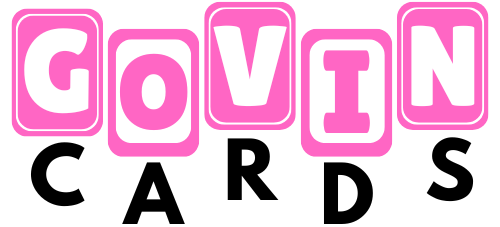Your child points at Hindi text in a book or on a sign and asks what those squiggly letters mean. Maybe grandparents speak Hindi at home, or you want your kids connected to their heritage. Perhaps you just think learning another writing system opens their minds to how diverse language can be.
These Hindi Alphabet Flashcards break down the Devanagari script into manageable pieces. Fifty-two cards covering vowels, consonants, and special characters that kids actually need to recognize and pronounce Hindi words.
Learning a new alphabet feels overwhelming at first. All those curves and lines look nothing like English letters. These cards take it slow, one character at a time, so kids build confidence instead of confusion.
Images



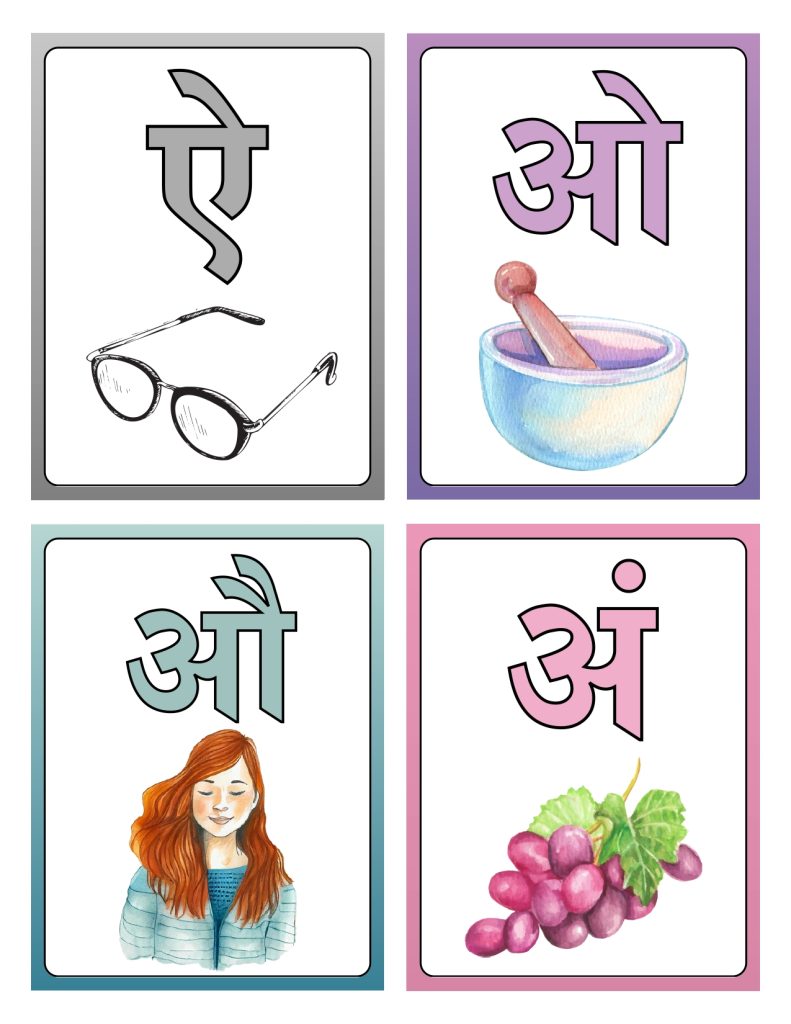
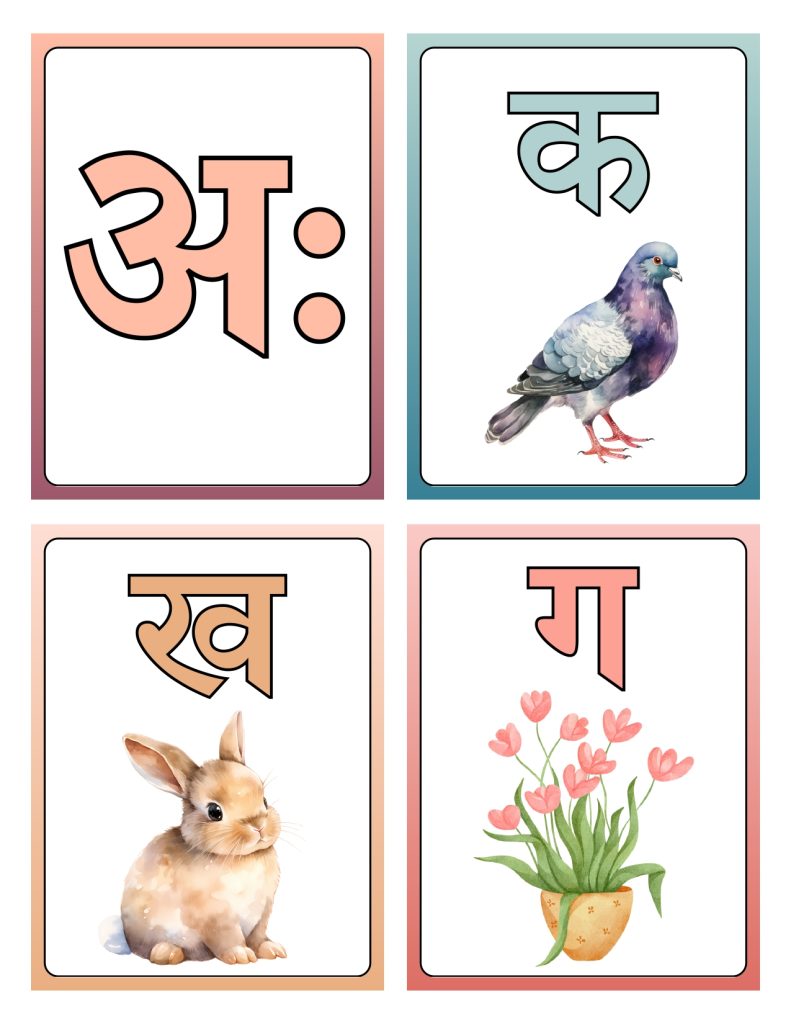

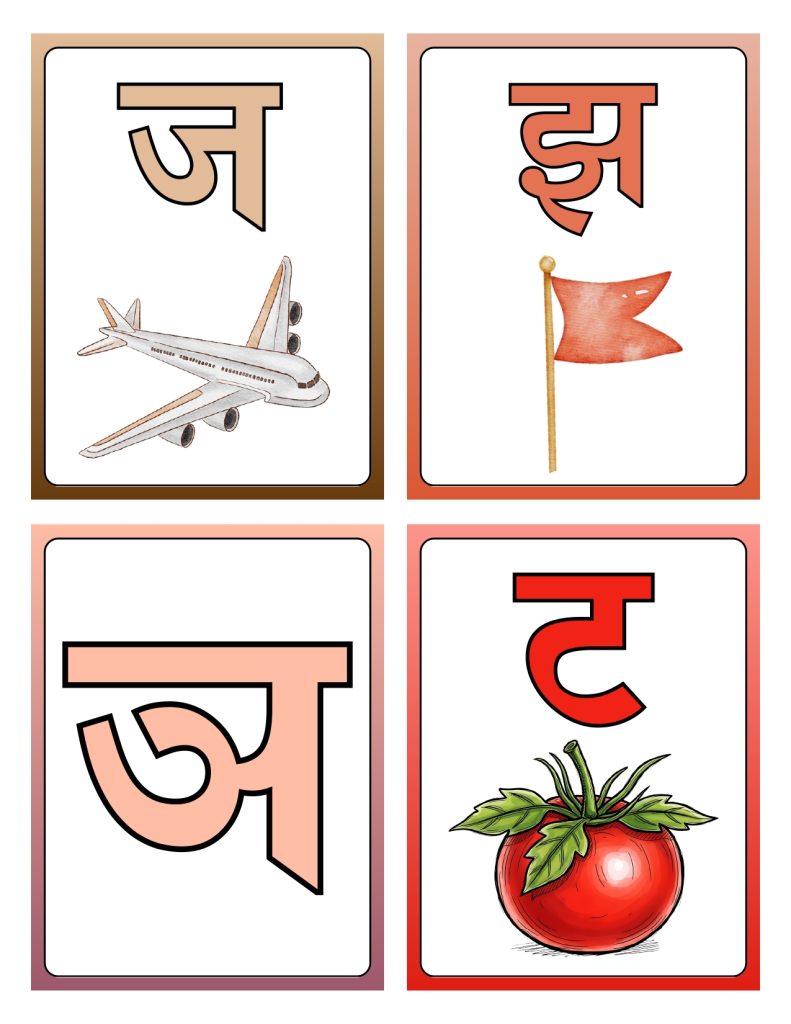
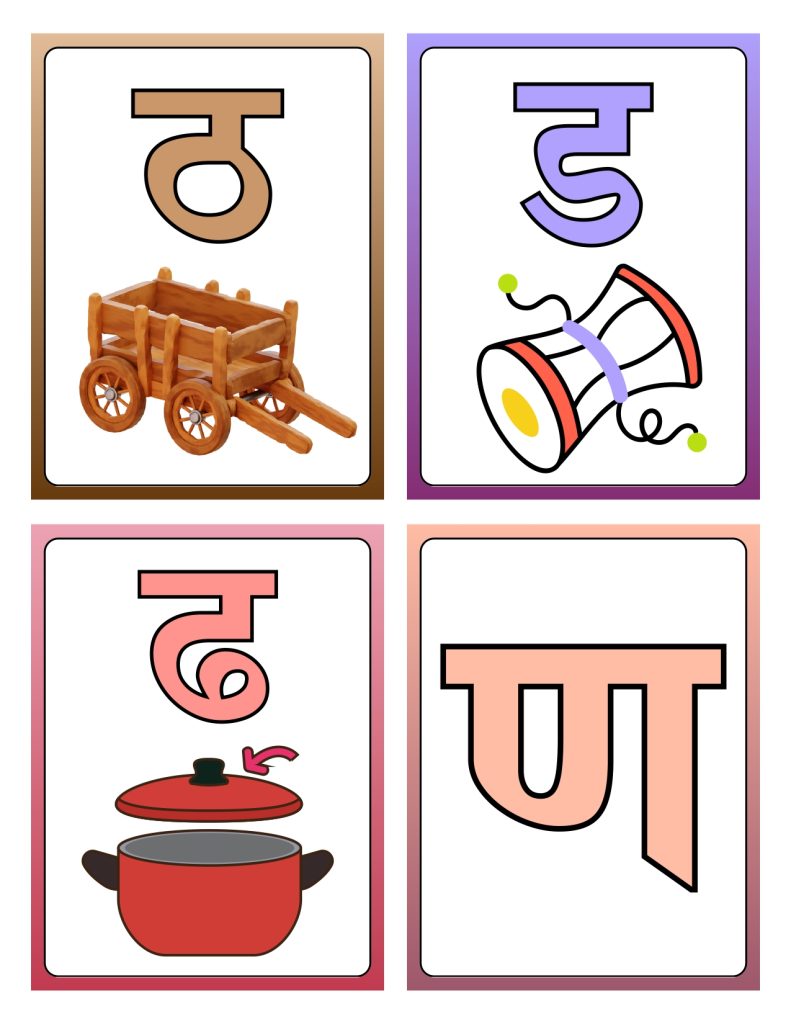

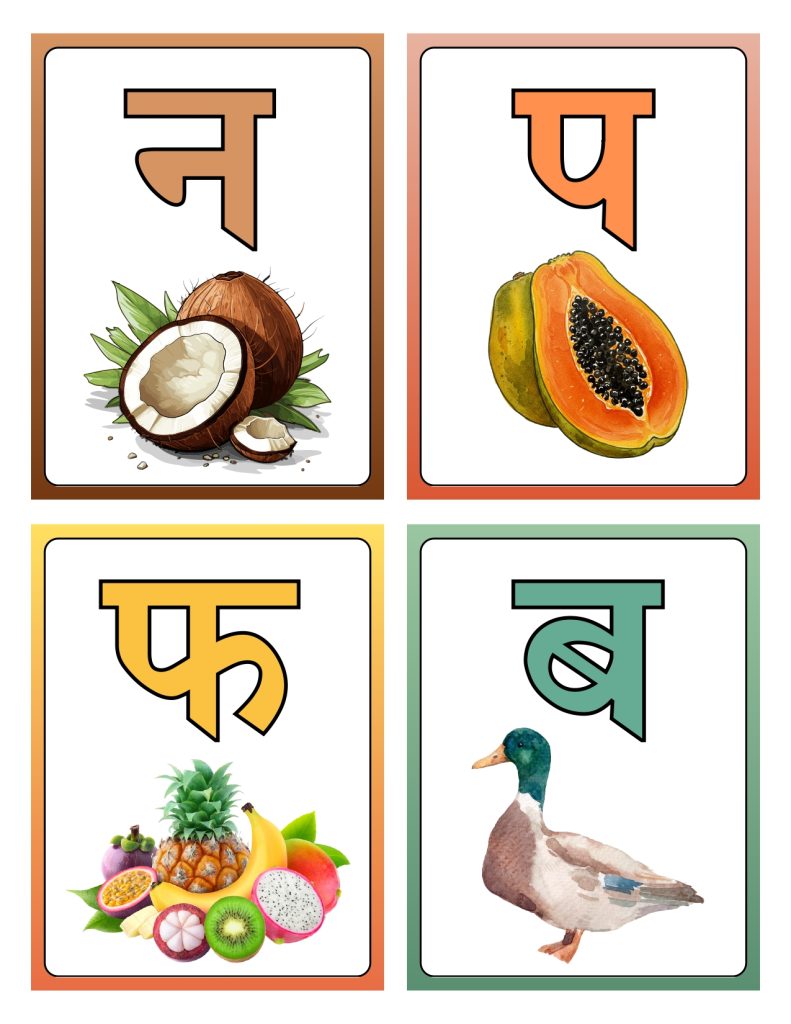




The Devanagari Script Basics
Hindi uses the Devanagari script, which works completely differently from English. Instead of 26 letters, there are 52 basic characters split into vowels and consonants. The good news is that Hindi spelling makes sense. Once kids know the sounds, they can read almost anything.
These flashcards cover the full traditional alphabet in the order Indian schools teach it. Starting with vowels because those are the building blocks, then moving through consonants, organized by where in your mouth you make the sound.
Understanding the Vowel Cards
The first section has thirteen vowel cards. Hindi distinguishes between short and long vowels, which English doesn’t really do. Getting these right matters because the wrong vowel length can change a word’s meaning completely.
- अ (a) sounds like the ‘u’ in ‘but’. Short and quick. Kids hear this constantly in common Hindi words.
- आ (aa) is the long version, like ‘a’ in ‘father’. Holding that sound longer completely changes words.
- इ (i) is short like ‘i’ in ‘bit’. Quick and clipped.
- ई (ee) stretches it out like ‘ee’ in ‘feet’. Same sound, just longer.
- उ (u) matches the ‘u’ in ‘put’. Short and simple.
- ऊ (oo) extends it like ‘oo’ in ‘boot’. Kids need to feel the difference in their mouths.
- ऋ (ri) doesn’t exist in English. It’s somewhere between ‘ri’ and ‘ru’. Takes practice.
- ए (e) sounds like ‘ay’ in ‘say’. Clear and strong.
- ऐ (ai) is like ‘ai’ in ‘aisle’. Slightly different from ए but important.
- ओ (o) matches ‘o’ in ‘go’. Straightforward sound.
- औ (au) sounds like ‘ow’ in ‘cow’. Kids get this one fast.
- अं (am) is a nasal sound. The little dot on top changes everything about how you say it.
- अः (ah) adds a slight breath at the end. Subtle but necessary for proper pronunciation.
The Consonant Cards
After vowels come thirty-three consonants, organized into groups based on how your tongue and throat work together to make each sound. Indian education systems teach them this way because it actually makes sense once you understand the pattern.
- The first group starts with क (ka), ख (kha), ग (ga), घ (gha), and ङ (nga). These all happen at the back of your throat. The difference between क and ख is aspiration, that little puff of air. Same with ग and घ. Kids feel this if they hold their hand in front of their mouth while practicing.
- Next come च (cha), छ (chha), ज (ja), झ (jha), and ञ (nya). Your tongue hits the roof of your mouth differently for these. च sounds like ‘ch’ in ‘chair’. ज is like ‘j’ in ‘jar’. The aspirated versions add that extra breath.
- Then ट (ta), ठ (tha), ड (da), ढ (dha), and ण (na). These retroflex sounds mean curling your tongue back. English doesn’t do this, so kids need extra practice. The tongue position completely changes the sound.
- The dental consonants त (ta), थ (tha), द (da), ध (dha), and न (na) use the front teeth. Similar sounds to the previous group but made differently. Hindi speakers hear the difference instantly, even though English speakers struggle at first.
- Labial consonants प (pa), फ (pha), ब (ba), भ (bha), and म (ma) all involve your lips. प sounds like ‘p’, फ like ‘ph’, ब like ‘b’, and म like ‘m’. These feel more familiar to English speakers.
- Semi-vowels and sibilants round things out: य (ya), र (ra), ल (la), व (va), श (sha), ष (sha), स (sa), and ह (ha). Each has its own distinct sound. र can be tricky because Hindi rolls it slightly. व sits somewhere between ‘v’ and ‘w’, depending on the word.
Special Combined Characters
Four special cards cover combinations that function as single units in Hindi. These show up constantly in actual Hindi text.
- क्ष (ksha) combines two sounds into something new. Kids see this in many common words.
- त्र (tra) blends together smoothly. Important for reading fluently.
- ज्ञ (gya) appears less often but matters for complete literacy.
- श्र (shra) completes the traditional alphabet. Once kids know these, they’ve covered the foundational characters.
Games That Build Recognition
- Sound Matching Challenge: Say a Hindi sound out loud and have kids race to find the matching card. Start with vowels since there are fewer. As they get better at it, throw in consonants. The act of physically grabbing cards while hearing sounds works way better than just sitting and staring at them.
- Character Slap: Spread all the cards face-up across the kitchen table. Call out a sound and see who can slap the right card fastest. Kids get seriously competitive about this, especially siblings. Whoever slaps it first keeps the card, and the person with the most cards at the end wins. This works great because kids stop thinking about studying and start thinking about crushing their brother or sister at the game.
- Storytelling with Letters: Grab five random cards and invent a silly story where each character becomes a character in your tale. Maybe क is a king, म is a monkey, and ह is a helpful hero. The story doesn’t have to make any sense. Kids remember letters way better when they’re woven into something funny you made up together. A ridiculous story about a monkey stealing the king’s crown will stick in their head forever. You can also combine it with interesting flashcards for 2-year-olds.
- Build a Word: Once kids recognize several characters, show them how to combine characters into actual words. Keep it simple at first with just two-character words. Let them arrange the cards to spell out whatever you say. This bridges the gap between knowing individual letters and understanding how real language works.
- Memory Pairs: Make two copies of each card. Shuffle everything face down and play the classic memory matching game. Kids flip two cards at a time, hunting for matches. This drills repetition into their brain without feeling like homework.
- Scavenger Hunt: Hide cards all over the house with little treats or stickers attached. Call out characters and send kids hunting for them. Finding ख tucked behind the couch transforms into a treasure hunt instead of a boring lesson.
- Real World Reading: Point out Hindi text on signs, products, or advertisements when you’re shopping or driving around town. Challenge kids to spot any characters they recognize. Watching their flashcard knowledge actually work in the real world gets them pumped to keep learning. You could also carry jobs flashcards for kids and include them in the game, making the learning process more interesting.
Why the Traditional Order Matters
These cards stick with the traditional Devanagari sequence because it genuinely makes learning easier. Grouping similar sounds together helps kids spot patterns they’d miss otherwise. Learning क, ख, ग, and घ as a set shows them how Hindi organizes sounds in a logical system.
Schools across India have used this exact sequence forever, and there’s a reason for that longevity. Moving from throat sounds to mouth sounds to lip sounds matches how your body physically produces speech. Kids pick up proper pronunciation almost automatically when they learn this way.
Print and Start Today
Download the PDF and print on regular paper using portrait orientation. Color printing makes characters easier to tell apart, but black and white gets the job done too. Use cardstock or laminate everything if you want cards that can handle the beating small hands will give them.
Cut along the borders and boom, you’ve got fifty-two cards ready to go. Begin with vowels, slowly add consonants, and watch your kid figure out the Hindi script one character at a time. Download to grab your printable Hindi Alphabet Flashcards and start this language adventure together.
